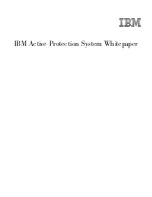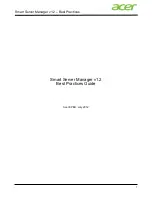
both Hub Operator and internal partner if they do not delegate the task of
configuring and monitoring the WebSphere Partner Gateway system to some
internal IT group or a third-party company.
External Partner
This is the partner with which the internal partner communicates. There can be
multiple partners of this type. If the partner has its own implementation of
WebSphere Partner Gateway, then it becomes the internal partner on its own
system and a external partner on this one.
Each of these profiles has at least one user ID. As mentioned above, Hub Operator
profile is the hubadmin super-user of the system. The other two profiles will each
have an admin user assigned to them upon initial creation. These users, in turn,
can create other users with equal or less abilities. Each of these admin users has
certain configuration abilities. For example, the hubadmin user can create any
object on the system such as the internal partner or load system-wide security
certificates. The internal partner role can create participants or connections. The
external partner role is the most limited in scope and can view its own documents
and configure the local destinations to which the internal partner has to deliver
documents.
Typographic conventions
This document uses the following conventions.
Table 1. Typographic conventions
Convention
Description
Monospace font
Text in this font indicates text that you type, values for
arguments or command options, examples and code
examples, or information that the system prints on the
screen (message text or prompts).
bold
Boldface text indicates graphical user interface controls (for
example, online button names, menu names, or menu
options) and column headings in tables and text.
italics
Text in italics indicates emphasis, book titles, new terms
and terms that are defined in the text, variable names, or
letters of the alphabet used as letters.
Italic monospace font
Text in italic monospace font indicates variable names
within monospace-font text.
ProductDir
ProductDir
represents the directory where the product is
installed. All IBM WebSphere Partner Gateway product
path names are relative to the directory where the IBM
WebSphere Partner Gateway product is installed on your
system.
%
text
%
and
$
text
Text within percent signs (%) indicates the value of the
Windows
(R)
text
system variable or user variable. The
equivalent notation in a UNIX
(R)
environment is
$
text
,
indicating the value of the
text
UNIX environment variable.
Underlined colored text
Underlined colored text indicates a cross-reference. Click the
text to go to the object of the reference.
2
IBM WebSphere Partner Gateway Enterprise and Advanced Editions: Administration Guide
Summary of Contents for E02HRLL-G - WebSphere Partner Gateway Express
Page 20: ...14 IBM WebSphere Partner Gateway Enterprise and Advanced Editions Administration Guide ...
Page 66: ...60 IBM WebSphere Partner Gateway Enterprise and Advanced Editions Administration Guide ...
Page 80: ...74 IBM WebSphere Partner Gateway Enterprise and Advanced Editions Administration Guide ...
Page 86: ...80 IBM WebSphere Partner Gateway Enterprise and Advanced Editions Administration Guide ...
Page 90: ...84 IBM WebSphere Partner Gateway Enterprise and Advanced Editions Administration Guide ...
Page 134: ...128 IBM WebSphere Partner Gateway Enterprise and Advanced Editions Administration Guide ...
Page 154: ...148 IBM WebSphere Partner Gateway Enterprise and Advanced Editions Administration Guide ...
Page 194: ...188 IBM WebSphere Partner Gateway Enterprise and Advanced Editions Administration Guide ...
Page 228: ...222 IBM WebSphere Partner Gateway Enterprise and Advanced Editions Administration Guide ...
Page 258: ...252 IBM WebSphere Partner Gateway Enterprise and Advanced Editions Administration Guide ...
Page 267: ......
Page 268: ... Printed in USA ...









































